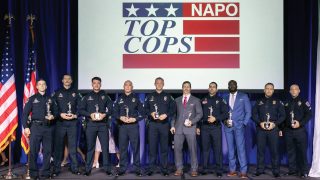Many words are being written and spoken now about the impact of the horrific and felonious death of George Floyd, a longtime Houstonian. For those within the law enforcement community who, like myself, have worked toward substantive reform within our organizations, this is a powerful and defining moment.
However, the measure of this moment will be revealed years from now. Then and only then will it be clear that efforts at substantive reform have largely succeeded, or succeeded in part, or woefully failed. Let us all rise to this moment.
Recently, I and many Houston police teammates had the honor — and it was an honor — of marching alongside more than 60,000 anguished protesters in downtown Houston for several hours. Of course, it was a tense and at times volatile situation. Everywhere I looked, I saw people who were hurting. Some quietly. Some loudly. I was surrounded by a sea of humanity wounded, concerned and clamoring to be heard.
I also witnessed more than a few of our own officers with a look on their faces that I hope to never see again: one of remorse and shame for what occurred in Minneapolis. As human beings and professionals, they know what they saw in the Minneapolis video. They know that it is not reflective of their oath or a life dedicated to service.
Yet, for all the wounds evidenced around me, we largely connected with each other. We knew that our only hope was to come together for the future of communities. We knew that we could no longer scurry off to separate corners and continue a pattern of isolation and separation that only reinforces stereotypes.
Whatever else I may have learned from my 34-plus years of policing faded into the background. I was a human being connecting with other human beings. This experience has left an imprint on my heart that calls for responsiveness.
American policing is at a defining point in time. We can respond — and this, too, is human — by being afraid. We may want to cling to old ways of thinking. But we can’t let fear — or fear’s cousin, habit — consume us or dictate our path forward. We must set our feet firmly upon the path of engagement.
In Houston, we refer to this path as “relational policing,” which is the recognition that every call, every visit is an opportunity to create relationships. Sometimes, this is just as basic as not letting our screens and devices receive more eye contact than our fellow citizens.
This is a quiet reform movement. In diplomatic terms, borrowing from the State Department, one can call this exercising “soft power.” It’s aimed at giving our fellow citizens daily reasons to believe that we are, indeed, a force for good. Because … we are a force for good.
In direct response to recent protests, Houston’s Mayor Sylvester Turner issued a far-ranging executive order about policing in our city. It addresses everything from response to resistance, de-escalation and shooting at moving vehicles to prohibited techniques (such as carotid control), the use of “no-knock” warrants and the duty to intercede.
It puts a critical stake in the ground and makes clear the kind of city and policing we already have and want to preserve. Our city is the most diverse in America. This diversity and ongoing dialogue has produced a powerful statement from a mayor who knows well the historic challenges, who understands the reality of systemic racism, yet who maintains a hard-won hope.
As you know, we have 18,000 separate police departments throughout America. This happened organically. After all, would anyone have purposefully designed such an unwieldy and inconsistent “system”?
This has produced a patchwork quilt of regulations and policies that is, in my opinion, counterproductive. In matters of life and death — and when other critical equities are in the balance — we owe it to our fellow citizens to make clear that there are standards of behavior from which we cannot deviate. We need national standards. Not to supplant or ignore local innovation. (Believe me, as an innovator, I want the power to continue innovating.) But we must make it plain the values we as a society and organizations believe in.
We can only move forward in unity with people we serve when we all change our mindset that respect for all and the sanctity of the lives of all we come in contact with are equally important. We must tactically approach situations in a manner that maximizes the safety of citizen, suspect and officer. To achieve this goal, we teach our officers on the first day of academy training that they will be held to task for following the tactics developed from the lessons learned throughout the law enforcement community from the blood, sweat, tears and lives lost throughout our history. To that end, it is time for all of us to be quick to critically think and assess before we act. We must all commit to the following tactical considerations when possible:
- Time: In most instances, time is on our side. Take the time to assess, plan and execute your response to a given situation.
- Distance: Maximize the use of distance for our own safety, and when necessary create distance to buy time and stay safe. The tragic death of Tamir Rice and many others may have been prevented had the officers responding to a “person with a gun” call not driven right up to him and instead stayed back and sought cover behind their patrol vehicle. Also, consider all the instances where citizens have lost their lives in a “suicide by cop” situation while threatening an officer with an edge weapon, in part, because the officers failed to de-escalate the situation by creating distance and maximizing the use of cover. If we go in foot pursuit of an individual with a Taser in hand, maintain a distance that is greater than the maximum effective range of the less-lethal weapon. Or, consider setting up a containment, call for air support, canine and additional resources. Or, like Stephen Smith, my first training officer in East Los Angeles, taught me in 1986, “A bad guy we don’t catch today, we will catch tomorrow, always assess risk versus gain (nature of the crime), never forget everyone’s safety comes first.”
- Numbers: We must always do our best to ensure we have sufficient resources on scene to safely handle a call. Consider staging near the scene of a call for service to ensure sufficient resources are on scene to safely render safe. This is especially critical in situations involving individuals in psychological distress in order to deploy tactics such as a swarm take down.
- Cover and concealment: We must maximize the use of cover and concealment in order to keep suspects and officers safe. A critical consideration is the importance of only having one officer “giving commands.” How many times have we seen incidents involving a person in psychological crises, and rather than having the contact officer give clear, concise and calm commands, a multitude of officers yell out commands, and sometimes commands that are conflicting, and rather than de-escalate the situation, we aggravate and make an already tense and dynamic situation worse.
In summary, all of us have a duty to respond to this moment.
The abuse of law enforcement power in the name of law, destroys law. It breaks the fundamental compact between our organizations and the citizens we are sworn to protect and serve.
Let us view the horror of Floyd’s death as a hard, searing invitation, yes, to comfort the grieving. That’s our first duty. Let’s march together in peace … and review prior choices in the light of a new day.
But we cannot stop there. Let’s adopt long-overdue reforms and champion the creation of national standards. But even that’s not enough.
We all must work together with relevant communities to ensure that years from now we are harvesting the fruits of measures we take today.
I am reminded of these words from Dr. Martin Luther King Jr.’s final Sunday sermon, delivered at the National Cathedral in Washington, D.C., before he was assassinated: “For some strange reason I can never be what I ought to be until you are what you ought to be. And you can never be what you ought to be until I am what I ought to be. This is the way God’s universe is made; this is the way it is structured.”
Hear that wise voice acknowledging our radical dependence. Heed the structure of God’s universe.
Finally, through this, through all of this, and once we emerge from this tumultuous time, I believe someday we will hear and finally understand the words from the Book of Revelation, “Behold, I make all things new.”
As seen in the July 2020 issue of American Police Beat magazine.
Don’t miss out on another issue today! Click below:





